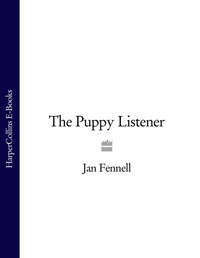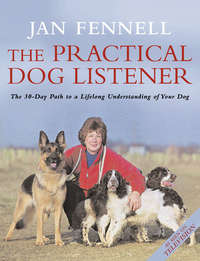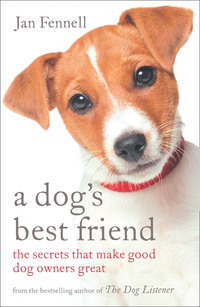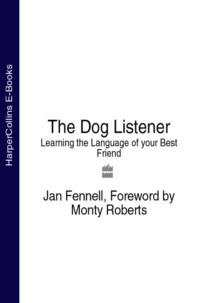
Полная версия
The Puppy Listener
DIFFERENT BREEDS, DIFFERENT DEMANDS
The tables on the following pages illustrate the different demands of dogs within each of the seven main groups.
KEY
SIZE
S Small
M Medium
L Large
X Extra large
GROOMING AND EXERCISE
L Little needed
M Moderate needed
C Considerable needed
LIFESPAN
A under 9 years on average
B 9–15 years on average
C over 15 years on average
DIFFERENT BREEDS – DIFFERENT DEMANDS
THE DIFFERENT REQUIREMENTS OF THE MOST POPULAR BREEDS
GUNDOGS/SPORTING
TYPE OF DOG: English Setter
SIZE: L
GROOMING: M
EXERCISE: C
LIFESPAN: B
TYPE OF DOG: German Longhaired Pointer
SIZE: L
GROOMING: M
EXERCISE: C
LIFESPAN: B
TYPE OF DOG: German Shorthaired Pointer
SIZE: L
GROOMING: L
EXERCISE: C
LIFESPAN: B
TYPE OF DOG: German Wirehaired Pointer
SIZE: L
GROOMING: M
EXERCISE: C
LIFESPAN: B
TYPE OF DOG: Gordon Setter
SIZE: L
GROOMING: M
EXERCISE: C
LIFESPAN: B
TYPE OF DOG: Hungarian Vizsla
SIZE: L
GROOMING: L
EXERCISE: C
LIFESPAN: B
TYPE OF DOG: Irish Red & White Setter
SIZE: L
GROOMING: M
EXERCISE: C
LIFESPAN: B
TYPE OF DOG: Irish Setter
SIZE: L
GROOMING: M
EXERCISE: C
LIFESPAN: B
TYPE OF DOG: Pointer
SIZE: L
GROOMING: L
EXERCISE: C
LIFESPAN: B
TYPE OF DOG: Retriever (Chesapeake Bay)
SIZE: L
GROOMING: M
EXERCISE: C
LIFESPAN: B
TYPE OF DOG: Retriever (Curly Coated)
SIZE: L
GROOMING: M
EXERCISE: C
LIFESPAN: B
TYPE OF DOG: Retriever (Flat Coated)
SIZE: L
GROOMING: M
EXERCISE: C
LIFESPAN: B
TYPE OF DOG: Retriever (Golden)
SIZE: L
GROOMING: M
EXERCISE: C
LIFESPAN: B
TYPE OF DOG: Retriever (Labrador)
SIZE: L
GROOMING: L
EXERCISE: C
LIFESPAN: B
TYPE OF DOG: Spaniel (American Cocker)
SIZE: M
GROOMING: C
EXERCISE: M
LIFESPAN: B
TYPE OF DOG: Spaniel (Cocker)
SIZE: M
GROOMING: C
EXERCISE: M
LIFESPAN: B
TYPE OF DOG: Spaniel (English Springer)
SIZE: M
GROOMING: M
EXERCISE: C
LIFESPAN: B
TYPE OF DOG: Spaniel (Field)
SIZE: M
GROOMING: M
EXERCISE: C
LIFESPAN: B
TYPE OF DOG: Spaniel (Irish Water)
SIZE: M
GROOMING: M
EXERCISE: C
LIFESPAN: B
TYPE OF DOG: Spaniel (Sussex)
SIZE: M
GROOMING: M
EXERCISE: C
LIFESPAN: B
TYPE OF DOG: Spaniel (Welsh Springer)
SIZE: M
GROOMING: M
EXERCISE: C
LIFESPAN: B
TYPE OF DOG: Spanish Water Dog
SIZE: M
GROOMING: M
EXERCISE: M
LIFESPAN: B
TYPE OF DOG: Weimaraner
SIZE: L
GROOMING: L
EXERCISE: C
LIFESPAN: B
WORKING
TYPE OF DOG: Alaskan Malamute
SIZE: L
GROOMING: C
EXERCISE: C
LIFESPAN: B
TYPE OF DOG: Bernese Mountain Dog
SIZE: X
GROOMING: M
EXERCISE: M
LIFESPAN: A
TYPE OF DOG: Bouvier Des Flandres
SIZE: L
GROOMING: C
EXERCISE: C
LIFESPAN: B
TYPE OF DOG: Boxer
SIZE: L
GROOMING: L
EXERCISE: C
LIFESPAN: B
TYPE OF DOG: Bullmastiff
SIZE: L
GROOMING: L
EXERCISE: C
LIFESPAN: B
TYPE OF DOG: Canadian Eskimo Dog
SIZE: L
GROOMING: M
EXERCISE: C
LIFESPAN: B
TYPE OF DOG: Doberman
SIZE: L
GROOMING: L
EXERCISE: C
LIFESPAN: B
TYPE OF DOG: German Pinscher
SIZE: M
GROOMING: L
EXERCISE: M
LIFESPAN: B
TYPE OF DOG: Giant Schnauzer
SIZE: L
GROOMING: C
EXERCISE: C
LIFESPAN: B
TYPE OF DOG: Great Dane
SIZE: X
GROOMING: L
EXERCISE: C
LIFESPAN: A
TYPE OF DOG: Mastiff
SIZE: X
GROOMING: L
EXERCISE: M
LIFESPAN: A
TYPE OF DOG: Newfoundland
SIZE: X
GROOMING: C
EXERCISE: C
LIFESPAN: B
TYPE OF DOG: Rottweiler
SIZE: L
GROOMING: L
EXERCISE: C
LIFESPAN: B
TYPE OF DOG: St Bernard
SIZE: X
GROOMING: C
EXERCISE: M
LIFESPAN: A
TYPE OF DOG: Siberian Husky
SIZE: L
GROOMING: M
EXERCISE: C
LIFESPAN: B
TERRIER
TYPE OF DOG: Airedale
SIZE: L
GROOMING: C
EXERCISE: M
LIFESPAN: B
TYPE OF DOG: Australian
SIZE: S
GROOMING: M
EXERCISE: M
LIFESPAN: B
TYPE OF DOG: Bedlington
SIZE: M
GROOMING: M
EXERCISE: M
LIFESPAN: B
TYPE OF DOG
TYPE OF DOG: Border
SIZE: S
GROOMING: M
EXERCISE: M
LIFESPAN: B
TYPE OF DOG: Bull
SIZE: M
GROOMING: L
EXERCISE: M
LIFESPAN: B
TYPE OF DOG: Bull (Miniature)
SIZE: M
GROOMING: L
EXERCISE: M
LIFESPAN: B
TYPE OF DOG: Cairn
SIZE: S
GROOMING: M
EXERCISE: M
LIFESPAN: B
TYPE OF DOG: Fox (Smooth)
SIZE: M
GROOMING: L
EXERCISE: M
LIFESPAN: B
TYPE OF DOG: Fox (Wire)
SIZE: M
GROOMING: C
EXERCISE: M
LIFESPAN: B
TYPE OF DOG: Irish
SIZE: M
GROOMING: M
EXERCISE: M
LIFESPAN: B
TYPE OF DOG: Kerry Blue
SIZE: M
GROOMING: C
EXERCISE: M
LIFESPAN: B
TYPE OF DOG: Lakeland
SIZE: M
GROOMING: C
EXERCISE: M
LIFESPAN: B
TYPE OF DOG: Norfolk
SIZE: S
GROOMING: M
EXERCISE: M
LIFESPAN: B
TYPE OF DOG: Parson Russell
SIZE: M
GROOMING: L
EXERCISE: M
LIFESPAN: B
TYPE OF DOG: Scottish
SIZE: M
GROOMING: C
EXERCISE: M
LIFESPAN: B
TYPE OF DOG: Skye
SIZE: M
GROOMING: M
EXERCISE: M
LIFESPAN: B
TYPE OF DOG: Staffordshire Bull
SIZE: M
GROOMING: L
EXERCISE: C
LIFESPAN: B
TYPE OF DOG: Welsh
SIZE: M
GROOMING: C
EXERCISE: M
LIFESPAN: B
TYPE OF DOG: West Highland White
SIZE: S
GROOMING: C
EXERCISE: M
LIFESPAN: B
HOUNDS
TYPE OF DOG: Afghan
SIZE: L
GROOMING: C
EXERCISE: C
LIFESPAN: B
TYPE OF DOG: Basenji
SIZE: M
GROOMING: L
EXERCISE: M
LIFESPAN: B
TYPE OF DOG: Basset Hound
SIZE: M
GROOMING: L
EXERCISE: C
LIFESPAN: B
TYPE OF DOG: Beagle
SIZE: M
GROOMING: L
EXERCISE: C
LIFESPAN: B
TYPE OF DOG: Bloodhound
SIZE: L
GROOMING: L
EXERCISE: C
LIFESPAN: A
TYPE OF DOG: Borzoi
SIZE: L
GROOMING: M
EXERCISE: C
LIFESPAN: B
TYPE OF DOG: Dachshund (Long or Wire Haired)
SIZE: M
GROOMING: M
EXERCISE: M
LIFESPAN: B
TYPE OF DOG: Dachshund (Miniature Long or Wire Haired)
SIZE: S
GROOMING: M
EXERCISE: M
LIFESPAN: C
TYPE OF DOG: Dachshund (Smooth Haired)
SIZE: M
GROOMING: L
EXERCISE: M
LIFESPAN: B
TYPE OF DOG: Dachshund (Miniature Smooth Haired)
SIZE: S
GROOMING: L
EXERCISE: M
LIFESPAN: C
TYPE OF DOG: Norwegian Elkhound
SIZE: L
GROOMING: M
EXERCISE: C
LIFESPAN: B
TYPE OF DOG: Foxhound
SIZE: L
GROOMING: L
EXERCISE: C
LIFESPAN: B
TYPE OF DOG: Greyhound
SIZE: L
GROOMING: L
EXERCISE: M
LIFESPAN: B
TYPE OF DOG: Irish Wolfhound
SIZE: X
GROOMING: M
EXERCISE: C
LIFESPAN: A
TYPE OF DOG: Pharaoh Hound
SIZE: L
GROOMING: L
EXERCISE: C
LIFESPAN: B
TYPE OF DOG: Rhodesian Ridgeback
SIZE: L
GROOMING: L
EXERCISE: C
LIFESPAN: B
TYPE OF DOG: Saluki
SIZE: L
GROOMING: M
EXERCISE: C
LIFESPAN: B
TYPE OF DOG: Whippet
SIZE: M
GROOMING: L
EXERCISE: C
LIFESPAN: B
PASTORAL/HERDING
TYPE OF DOG: Anatolian Shepherd
SIZE: L
GROOMING: M
EXERCISE: C
LIFESPAN: B
TYPE OF DOG: Australian Cattle
SIZE: M
GROOMING: L
EXERCISE: M
LIFESPAN: B
TYPE OF DOG: Australian Shepherd
SIZE: L
GROOMING: M
EXERCISE: C
LIFESPAN: B
TYPE OF DOG: Bearded Collie
SIZE: L
GROOMING: C
EXERCISE: M
LIFESPAN: B
TYPE OF DOG: Border Collie
SIZE: M
GROOMING: M
EXERCISE: C
LIFESPAN: B
TYPE OF DOG: Collie (Rough)
SIZE: L
GROOMING: C
EXERCISE: C
LIFESPAN: B
TYPE OF DOG: Collie (Smooth)
SIZE: L
GROOMING: L
EXERCISE: C
LIFESPAN: B
TYPE OF DOG: German Shepherd
SIZE: L
GROOMING: M
EXERCISE: C
LIFESPAN: B
TYPE OF DOG: Old English Sheepdog
SIZE: L
GROOMING: C
EXERCISE: C
LIFESPAN: B
TYPE OF DOG: Pyrenean Mountain Dog
SIZE: X
GROOMING: C
EXERCISE: M
LIFESPAN: A
TYPE OF DOG: Pyrenean Sheepdog
SIZE: M
GROOMING: M
EXERCISE: M
LIFESPAN: B
TYPE OF DOG: Samoyed
SIZE: L
GROOMING: C
EXERCISE: C
LIFESPAN: B
TYPE OF DOG: Shetland Sheepdog
SIZE: M
GROOMING: C
EXERCISE: M
LIFESPAN: B
TYPE OF DOG: Welsh Corgi (Cardigan)
SIZE: M
GROOMING: L
EXERCISE: M
LIFESPAN: B
TYPE OF DOG: Welsh Corgi (Pembroke)
SIZE: M
GROOMING: L
EXERCISE: M
LIFESPAN: B
TOYS
TYPE OF DOG: Affen Pinscher
SIZE: S
GROOMING: M
EXERCISE: L
LIFESPAN: B
TYPE OF DOG: Australian Silky Terrier
SIZE: S
GROOMING: M
EXERCISE: L
LIFESPAN: B
TYPE OF DOG: Bichon Frise
SIZE: S
GROOMING: C
EXERCISE: L
LIFESPAN: B
TYPE OF DOG: Cavalier King Charles Spaniel
SIZE: S
GROOMING: M
EXERCISE: M
LIFESPAN: B
TYPE OF DOG: Chihuahua (Long Coat)
SIZE: S
GROOMING: M
EXERCISE: L
LIFESPAN: B
TYPE OF DOG: Chihuahua (Smooth Coat)
SIZE: S
GROOMING: L
EXERCISE: L
LIFESPAN: B
TYPE OF DOG: English Toy Terrier (Black and Tan)
SIZE: S
GROOMING: L
EXERCISE: L
LIFESPAN: B
TYPE OF DOG: Maltese
SIZE: S
GROOMING: C
EXERCISE: L
LIFESPAN: B
TYPE OF DOG: Miniature Pinscher
SIZE: S
GROOMING: L
EXERCISE: L
LIFESPAN: B
TYPE OF DOG: Papillon
SIZE: S
GROOMING: M
EXERCISE: L
LIFESPAN: B
TYPE OF DOG: Pekingese
SIZE: S
GROOMING: C
EXERCISE: L
LIFESPAN: B
TYPE OF DOG: Pomeranian
SIZE: S
GROOMING: C
EXERCISE: L
LIFESPAN: B
TYPE OF DOG: Pug
SIZE: S
GROOMING: L
EXERCISE: L
LIFESPAN: B
TYPE OF DOG: Yorkshire Terrier
SIZE: S
GROOMING: C
EXERCISE: L
LIFESPAN: B
UTILITY
TYPE OF DOG: Akita
SIZE: L
GROOMING: M
EXERCISE: C
LIFESPAN: B
TYPE OF DOG: Boston Terrier
SIZE: S
GROOMING: L
EXERCISE: M
LIFESPAN: B
TYPE OF DOG: Bulldog
SIZE: M
GROOMING: L
EXERCISE: M
LIFESPAN: A
TYPE OF DOG: Chow Chow
SIZE: L
GROOMING: C
EXERCISE: M
LIFESPAN: B
TYPE OF DOG: Dalmatian
SIZE: L
GROOMING: L
EXERCISE: C
LIFESPAN: B
TYPE OF DOG: French Bulldog
SIZE: S
GROOMING: L
EXERCISE: M
LIFESPAN: B
TYPE OF DOG: German Spitz (Klein)
SIZE: S
GROOMING: C
EXERCISE: L
LIFESPAN: B
TYPE OF DOG: German Spitz (Mittel)
SIZE: M
GROOMING: C
EXERCISE: L
LIFESPAN: B
TYPE OF DOG: Japanese Shiba Inu
SIZE: M
GROOMING: M
EXERCISE: M
LIFESPAN: B
TYPE OF DOG: Japanese Spitz
SIZE: M
GROOMING: C
EXERCISE: M
LIFESPAN: B
TYPE OF DOG: Lhasa Apso
SIZE: S
GROOMING: C
EXERCISE: L
LIFESPAN: B
TYPE OF DOG: Mexican Hairless
SIZE: M
GROOMING: L
EXERCISE: M
LIFESPAN: B
TYPE OF DOG: Miniature Schnauzer
SIZE: S
GROOMING: C
EXERCISE: M
LIFESPAN: B
TYPE OF DOG: Poodle (Miniature)
SIZE: M
GROOMING: C
EXERCISE: M
LIFESPAN: C
TYPE OF DOG: Poodle (Standard)
SIZE: L
GROOMING: C
EXERCISE: C
LIFESPAN: C
TYPE OF DOG: Poodle (Toy)
SIZE: S
GROOMING: C
EXERCISE: M
LIFESPAN: C
TYPE OF DOG: Schnauzer
SIZE: M
GROOMING: C
EXERCISE: M
LIFESPAN: B
TYPE OF DOG: Shar Pei
SIZE: M
GROOMING: L
EXERCISE: M
LIFESPAN: B
TYPE OF DOG: Shih Tzu
SIZE: S
GROOMING: C
EXERCISE: M
LIFESPAN: B
TYPE OF DOG: Tibetan Spaniel
SIZE: S
GROOMING: M
EXERCISE: M
LIFESPAN: C
TYPE OF DOG: Tibetan Terrier
SIZE: M
GROOMING: C
EXERCISE: M
LIFESPAN: B
CHOOSING A PUPPY
You’ve selected the breed of dog you want, you’ve found a good breeder or rescue centre, and now it’s time to pick the individual puppy you will take home with you. A good breeder will be able to brief you on the personalities of the puppies in a litter and will try to help you choose a dog that will suit your lifestyle. They don’t want to place an extrovert dog with an owner who is looking for a quiet companion; nor do they want to place a very docile, shy dog with someone who intends leading a very active outdoor life with that dog. The consequences of mismatching dogs and their owners can be awful.
Broad personality types are often apparent early on when the litter is first formed. There are the strong characters who dominate the best feeding positions when suckling from the mother’s teats, and there are the weaker members who have been knocked away from these positions and literally have to fight for their food – and their survival. But personality is a more complex matter than this and requires a little study. With the first part of their development well under way, the five or six week mark offers the perfect opportunity to conduct a simple personality test that will answer many of your questions.
There are all sorts of theories about how to conduct personality tests on dogs – many of them bordering on the barbaric. For instance, some people advocate pinching the dog to see how it reacts. I can think of nothing worse. The following three simple tests will give you all the information you need, without resorting to violence or cruelty.
TESTING BY EYE
The first clues about character come early on. By watching which puppies get to the teat first you can spot the dominant characters as well as the shy, retiring ones that get pushed to the back of the litter. This continues as the puppies emerge from under their mother’s wing. As they begin to play and interact, you may notice that one takes toys from another. Is there one that just sits there and watches while the others play? You can see that this dog is a thinker, one who will always weigh up its options in life before making its move.
There are signals in terms of body language too, with some dogs looking to assert themselves by placing their bodies over pups they consider to be subordinate. Of course, testing by eye isn’t going to tell you everything, so there are a couple of physical tests you can try to fill in the picture.
TESTING IN THE PALM OF THE HAND
This is designed to test the puppy’s reaction to being lifted. It will, of course, be used to this by now, but the way it reacts each time speaks volumes.
Lift the puppy off the ground. Place it in the palm of one hand (or two hands if it is a larger breed) and leave it there for ten seconds or so.
• If it goes limp in your hand, it is likely to be a more relaxed personality.
• If it starts to struggle immediately that indicates it is more stubborn and more likely to challenge you. It might also be a sign of a nervous dog.
• If it stays there for a little while then starts to struggle, that indicates a dog who thinks about things first before acting.
TESTING BY LYING THE PUPPY ON ITS BACK
This is designed to test the puppy’s reaction to being turned on its back. As with the palm of the hand test, it is not something you should do for long – ten seconds at the absolute maximum.
Lift the puppy and carefully cradle it in your arms. Placing a hand on each side, lift it up and turn it so it is lying on its back in your arms. Five distinct personality types will reveal themselves as follows.
The defiant one
Some puppies simply will not have it. The moment you turn them over they will immediately right themselves, and they will repeat the process every time you try. This dog is going to grow into a strong character, an alpha type. It will take strong, firm and clear leadership to keep it on the straight and narrow.
The resistance fighter
This one will fight you at first, but will eventually comply and lie on its back, under protest. This again is a dog that may present a few problems, but one who will respond to the right signals.
The thinker
Some puppies will initially lie down willingly. They will stay there for a couple of seconds then spring back upright. This indicates a dog that has weighed up the situation, come to a decision – that it doesn’t like this – and acted upon it. This is a dog that has a lot of courage and intelligence.
The cool customer
Some pups present no resistance whatsoever; they simply go limp and lie there. This is a chilled-out, laid-back individual. With the right guidance, this is going to be a relatively trouble-free dog.
The bundle of nerves
Some puppies will curl up in a ball almost foetally. This is a sure sign of nervousness in the dog. A dog that reacts this way is going to be prone to anxiety attacks when they hear loud noises or are faced with strange situations. In the worst cases, they may develop problems such as wetting themselves. By identifying them as nervous dogs, however, you can factor this personality into your life with the dog and act accordingly, hopefully avoiding problems.
* * * * * * *
Choose a dog with a personality type that is going to fit with the lifestyle you want to introduce it to, whether that be noisy city life or a quiet country existence, and you’ll have a head start in getting it to adapt to its new home when it gets there.
CANINE COMPANIONSHIP
Dogs share the human’s sense of family values. In general, they enjoy company, whether human or canine, in the home. This sociable nature may be rooted in their ancient past, when they were forming the first communities with our ancient ancestors. But it may go deeper than that. Why else would man have chosen the wolf above any other creature to domesticate first? Did they see them as more companionable than any other animal? It is food for thought.
If you already have a dog at home and want to introduce a new one, it should be planned with care. Introducing an eight-week-old dog to an existing pack is a relatively straightforward process, but you might have more difficulty with a slightly older dog. Bringing a nine-month-old puppy into a home is the equivalent of introducing a hyperactive 12-year-old child. Older dogs, in particular, may not take kindly to their peace and quiet being disturbed.
There are other factors to consider too, as dogs can find it hard to read signals from breeds that are physically different from them. While a toy Poodle and an Irish Wolfhound will get along together eventually, there may be a great deal of friction because of the huge differences in their physical make-up before they settle into a routine together. There’s more about dogs’ abilities to understand each other’s signals on pages 172–8.
For all these reasons, it is advisable to introduce the new dog to its prospective pack as soon as possible. It would be ideal if you could take the existing dog or dogs to the breeder from where the eight-week-old puppy is coming and introduce them there. This has several obvious advantages. In territorial terms, it is neutral ground. The new arrival will also be amongst people who know and can control it in the event of problems. Most importantly of all, if after a few meetings there is clearly a high degree of friction between the old and new dogs, the potential owner will have the chance to think again.









